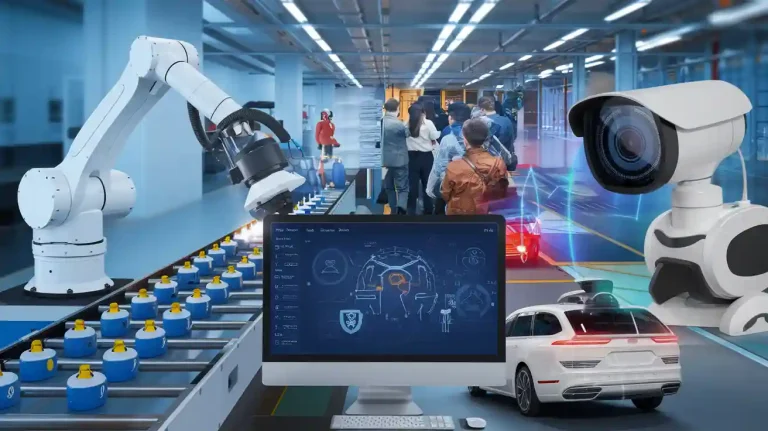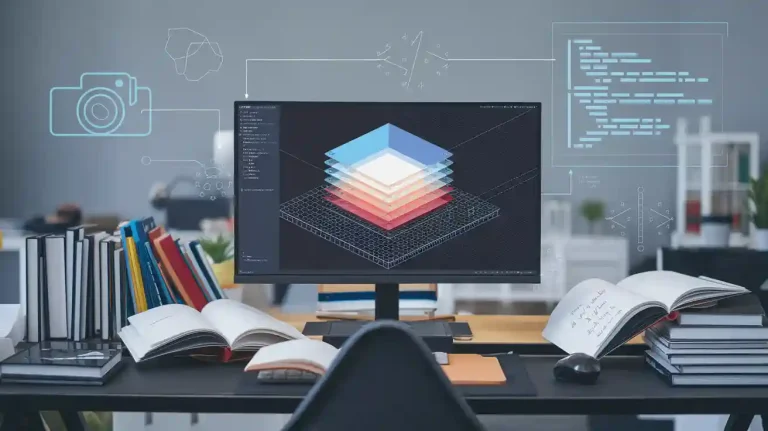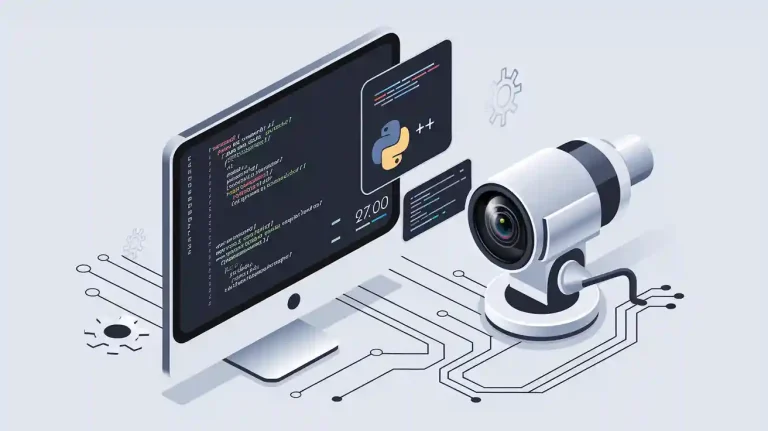
A reinforcement learning machine vision system uses reinforcement to help a machine learn from visual data. This system connects reinforcement with machine vision to allow intelligent decision-making. Deep reinforcement learning gives the machine vision system the power to handle complex images. The machine can improve its vision by learning from feedback. Each reinforcement learning machine vision system uses deep reinforcement learning to boost accuracy. Deep reinforcement learning lets the machine vision system adapt to new situations. These systems rely on reinforcement to guide learning and make vision smarter.
A reinforcement learning machine vision system combines reinforcement, learning, and machine vision for smarter visual tasks.
Key Takeaways
- A reinforcement learning machine vision system helps machines learn from visual feedback to improve tasks like object detection and navigation.
- The system combines cameras, lighting, processors, and software to capture and analyze images, guiding machines to make smarter decisions.
- Deep reinforcement learning uses neural networks to handle complex images and helps machines adapt to new situations without retraining.
- These systems are widely used in robotics, autonomous vehicles, and medical imaging to improve accuracy and safety.
- While powerful, these systems need lots of data, strong hardware, and clear feedback to learn effectively and face challenges like transparency.
Core Concepts
Reinforcement Learning
Reinforcement learning helps a machine learn by using feedback from its environment. The machine acts, receives a reward or penalty, and then adjusts its actions to get better results. This process repeats many times. The machine learns which actions lead to higher rewards. Reinforcement guides the machine to make smarter choices over time. In a reinforcement learning machine vision system, this approach allows the machine to improve its visual understanding. The machine does not need direct instructions. Instead, it learns from experience and feedback. This method supports continuous improvement and adaptability.
Machine Vision
A machine vision system gives a machine the ability to see and interpret visual information. Cameras and sensors collect images or video. The machine processes this data to recognize objects, patterns, or movements. Machine vision helps the machine understand its surroundings. The system can identify shapes, colors, and textures. It can also measure distances and detect changes in the environment. Machine vision systems work in many fields, such as manufacturing, healthcare, and robotics. These systems help machines perform tasks that require sight, like sorting items or guiding robots.
Integration
A reinforcement learning machine vision system combines reinforcement and machine vision to create a powerful tool. The machine uses vision to observe its environment. It then uses reinforcement to learn the best actions based on what it sees. Deep reinforcement learning plays a key role in this integration. Neural networks help the machine handle complex images and high-dimensional data. Deep reinforcement learning methods, such as Deep Q-Networks (DQN), Proximal Policy Optimization (PPO), and Advantage Actor-Critic (A2C), allow the machine to solve tasks like object detection, image segmentation, and grasp planning.
The integration process often starts in simulated environments. This approach lets the machine vision system learn safely and quickly. The machine can practice many scenarios without real-world risks. Multi-agent systems also help, where several machines work together on vision tasks. These systems use decentralized decision-making and communication to improve scalability and adaptability.
However, integration brings challenges. The high dimensionality of visual data makes learning difficult. The machine must process large amounts of information quickly. Real-time decision-making requires fast and efficient algorithms. Communication between machines in multi-agent systems can be hard, especially with limited connectivity. Ethical concerns, such as bias in datasets and the black box nature of deep reinforcement learning, affect transparency and fairness. Tools like AI Fairness 360 and TuringBox help monitor and reduce bias. Reward feedback and closed-loop designs improve learning efficiency and adaptability.
A reinforcement learning machine vision system uses these integration methods to create smarter, more flexible machines. Deep reinforcement learning enables the machine vision system to adapt to new tasks and environments without retraining. This combination supports continuous learning and better decision-making in complex visual tasks.
System Architecture

Key Components
A reinforcement learning machine vision system uses several important parts to work well. Each part has a special job. The table below shows the four main components and how each one helps the system:
| Component | Contribution to System Functionality |
|---|---|
| Cameras | Act as the eyes of the system by capturing high-resolution images or videos of objects or scenes. They vary in type (monochrome or color), resolution, and frame rate to suit inspection needs. |
| Lighting | Provides proper illumination to highlight object features, ensuring clear and consistent image capture. Different lighting techniques are used depending on inspection requirements. |
| Processors | Serve as the brain by running image processing algorithms such as edge detection, pattern recognition, and measurements to analyze visual data. Can be standalone or integrated (smart cameras). |
| Software | Offers tools and algorithms for image analysis, translating visual data into actionable information like defect detection, dimension measurement, and barcode reading. Allows customization of inspection parameters. |
The cameras collect images or video. Lighting makes sure the images are clear. Processors handle the heavy work of analyzing the pictures. Software turns the results into useful information. These four parts work together to help the machine see and understand its world.
A reinforcement learning agent uses these components to interact with its environment. The agent observes the world through cameras and sensors. The agent then decides what action to take based on what it sees. The system uses reinforcement to guide the agent’s choices. The agent learns which actions lead to better results.
Data Flow
The data flow in a reinforcement learning machine vision system starts with the cameras. The cameras capture images or video of the environment. Lighting helps the cameras get the best view. The processors receive the visual data and run deep reinforcement learning algorithms. These algorithms use neural networks to process the images. The machine vision system can recognize objects, track movement, and measure distances.
The software then analyzes the processed data. It looks for patterns, detects objects, and checks for defects. The reinforcement learning agent uses this information to make decisions. The agent chooses an action, such as moving a robot arm or sorting an item. The environment responds to the action. The system then gives feedback to the agent. This feedback is called a reward or penalty.
The agent uses reinforcement to learn from the feedback. The agent repeats this process many times. Over time, the agent gets better at making decisions. Deep reinforcement learning helps the machine handle complex images and large amounts of data. The system can adapt to new tasks and environments without starting over.
Tip: Deep reinforcement learning allows the machine vision system to learn from experience, not just from rules.
Reward Mechanism
The reward mechanism is a key part of a reinforcement learning machine vision system. The system gives the agent a reward when it makes a good decision. If the agent makes a mistake, it gets a penalty. The agent uses reinforcement to learn which actions lead to higher rewards.
The reward function tells the agent what is good or bad. For example, if the agent finds a defect in a product, it gets a reward. If it misses the defect, it gets a penalty. The agent tries to get more rewards and fewer penalties. This process helps the agent improve its vision and decision-making skills.
Deep reinforcement learning makes the reward mechanism stronger. Neural networks help the agent understand complex feedback. The agent can learn from many different situations. The machine vision system becomes smarter and more flexible.
A reinforcement learning agent uses the reward mechanism to guide its actions. The agent learns to choose the best action for each situation. The system can handle tasks like object detection, tracking, and sorting. Deep reinforcement learning helps the agent learn faster and perform better.
Deep Reinforcement Learning
Neural Networks
Deep reinforcement learning uses neural networks to help a machine learn from complex visual data. Neural networks act like a brain for the machine. They process images and help the machine understand what it sees. Deep reinforcement learning connects reinforcement with these networks. The machine receives feedback and uses it to improve its vision. Neural networks allow the machine to handle many types of images. They help the machine learn patterns, shapes, and colors. Deep reinforcement learning makes the machine better at object detection and tracking. The machine can see changes in the environment and react quickly.
High-Dimensional Vision Tasks
Deep reinforcement learning helps a machine vision system solve high-dimensional vision tasks. These tasks include object detection, image segmentation, and tracking. The machine must look at many details in each image. Deep reinforcement learning gives the machine the power to focus on important features. The machine learns which parts of the image matter most for object detection. Tracking moving objects becomes easier with deep reinforcement learning. The machine can follow objects across many frames. Deep reinforcement learning also helps with tasks like sorting items and finding defects. The machine vision system becomes more accurate and reliable.
Training Methods
Training a machine with deep reinforcement learning involves many steps. The machine starts by looking at images and making guesses. It receives reinforcement in the form of rewards or penalties. The machine uses this feedback to change its actions. Deep reinforcement learning repeats this process many times. The machine learns which actions lead to better results. Training often uses large datasets with many images. The machine practices object detection, tracking, and other vision tasks. Deep reinforcement learning helps the machine adapt to new situations. The machine can learn from mistakes and improve over time. This method makes the machine vision system smarter and more flexible.
Note: Deep reinforcement learning allows a machine to solve vision problems that were too hard before. It helps with object detection, tracking, and many other tasks.
Applications

Robotics
Robotics uses deep reinforcement learning to improve navigation and vision. Robots learn to move through complex spaces by using cameras and sensors. The machine vision system helps robots see objects and avoid obstacles. Deep reinforcement learning allows the robot to adjust its path when it faces new challenges. Robots in factories use vision for sorting, picking, and placing items. They learn from feedback and improve their actions over time. Multi-agent systems let several robots work together. These robots share information and learn faster. Open-source tools like TensorFlow and PyTorch help researchers build better machine vision systems for robotics.
Autonomous Vehicles
Autonomous vehicles rely on deep reinforcement learning for safe and efficient navigation. The machine uses vision to detect lanes, signs, and other vehicles. Deep reinforcement learning helps the vehicle learn how to make quick decisions. The system uses navigation data to plan routes and avoid accidents. Autonomous systems in cars use object detection and tracking to follow moving objects. Training in simulated environments helps vehicles learn without real-world risks. Recent advances in reinforcement learning, such as DQN and PPO, have made navigation more reliable. These methods allow autonomous vehicles to adapt to changing road conditions.
Medical Imaging
Medical imaging benefits from deep reinforcement learning and machine vision. The machine learns to spot patterns in X-rays, MRIs, and CT scans. Vision systems help doctors find tumors and other health issues. Deep reinforcement learning improves the accuracy of image analysis. The system learns from large datasets and gets better at detecting small changes. Hospitals use autonomous systems to guide robots during surgery. These robots use navigation and vision to move safely. Research teams use open-source platforms to share new methods. Recent advances in reinforcement and learning have reduced errors and improved patient care.
Note: Recent innovations in deep reinforcement learning, simulated environments, and multi-agent systems have made navigation and vision tasks smarter and more adaptive across robotics, autonomous vehicles, and healthcare.
Benefits and Challenges
Advantages
A reinforcement learning machine vision system brings many benefits. Deep reinforcement learning gives the system strong adaptability. The machine can learn from feedback and improve its actions. Reinforcement helps the system adjust to new tasks and environments. The vision part lets the machine see and understand objects. Deep reinforcement learning increases accuracy in object detection and tracking. The system can handle complex navigation tasks. Reinforcement allows the machine to keep learning and get better over time. The machine vision system supports continuous improvement. Navigation becomes safer and more reliable with deep reinforcement learning. The system can work in factories, hospitals, and autonomous vehicles.
Tip: Deep reinforcement learning helps a machine vision system learn from mistakes and improve its navigation skills.
Limitations
A reinforcement learning machine vision system faces some challenges. Deep reinforcement learning needs a lot of data and time for training. The machine may struggle with high-dimensional vision tasks. Reinforcement can be slow if the reward signals are rare or unclear. The system may need powerful hardware for fast navigation and learning. Sometimes, the machine cannot explain its decisions. This lack of transparency can cause trust issues. The vision system may also face problems with poor lighting or unclear images. Reinforcement learning agent performance depends on good feedback. If the environment changes too quickly, the machine may not adapt fast enough.
| Challenge | Possible Solution |
|---|---|
| Slow learning | Use better reward signals |
| High data needs | Use simulated environments |
| Lack of transparency | Add explainable AI tools |
| Hardware limits | Use cloud-based processing |
Future Trends
Deep reinforcement learning will shape the future of machine vision systems. Researchers will create smarter navigation methods. Machines will learn faster and with less data. Reinforcement will help autonomous systems handle new environments. Vision systems will become more accurate in object detection and tracking. The machine will use better sensors for clearer images. Navigation in complex spaces will improve. Deep reinforcement learning will support safer autonomous vehicles and robots. The future will bring more teamwork between machines. Reinforcement will guide learning in real time. Machine vision systems will keep growing in healthcare, industry, and transportation.
A reinforcement learning machine vision system uses learning to help machines see, understand, and act in complex environments. These systems offer strong adaptability and can handle tasks like object detection, tracking, and navigation. The table below shows how their benefits and challenges compare to rule-based systems:
| Aspect | Rule-Based Machine Vision | Computer Vision with Reinforcement Learning |
|---|---|---|
| Benefits | Fast, predictable | Flexible, adaptable, learns over time |
| Challenges | Inflexible, limited | Needs more data, complex, slower |
Learning in these systems requires powerful hardware and large datasets. Autonomous systems use learning to improve over time. Readers can follow new research and community discussions to keep up with advances in learning, explainable AI, and ethical design. The table below lists helpful resources:
| Resource/Topic | Description | Example/Details |
|---|---|---|
| Community Discussions | Forums on RL and vision integration | DeepLearning.AI Forum |
| Research Papers | New frameworks for semantic rewards | VLM-RL for autonomous driving |
| Explainable RL | Tools for understanding RL decisions | Retrospex for healthcare and finance |
| Model-Based RL | Efficient planning algorithms | DreamerV3, TD-MPC2 |
| Newsletters | Updates on RL and machine vision | The Batch by Andrew Ng |
| Ethical RL | Fairness and human-centric learning | Imitation learning, multi-agent systems |
Learning will keep making machine vision systems smarter and more useful in many fields.
FAQ
What makes a reinforcement learning machine vision system different from traditional vision systems?
A reinforcement learning machine vision system learns from feedback. Traditional systems follow fixed rules. The reinforcement learning agent adapts to new tasks and environments. This approach helps the machine improve object detection, tracking, and navigation over time.
How does deep reinforcement learning help with object detection and tracking?
Deep reinforcement learning uses neural networks to process images. The machine learns to spot objects and follow them in real time. This method improves accuracy in object detection and tracking, even in complex or changing environments.
Can a machine vision system using reinforcement handle autonomous navigation?
Yes. A machine vision system with reinforcement can guide autonomous systems. The machine learns to make decisions for safe navigation. It avoids obstacles and adapts to new routes. This helps robots and vehicles move safely in different settings.
Why do autonomous systems need reinforcement learning agents?
Autonomous systems face changing environments. A reinforcement learning agent helps the machine learn from experience. The agent improves vision, tracking, and navigation. This learning process allows autonomous systems to adapt and perform better over time.
What are some real-world uses for reinforcement learning machine vision systems?
Factories use these systems for sorting and inspection. Hospitals use them for medical imaging. Autonomous vehicles rely on them for navigation and object detection. Deep reinforcement learning helps machines handle complex vision tasks in many industries.
See Also
Ways Deep Learning Improves The Performance Of Machine Vision
Understanding Pattern Recognition In Machine Vision Technologies
Exploring Predictive Maintenance Using Advanced Machine Vision Systems
Defining Automotive Applications Of Machine Vision Systems Today









